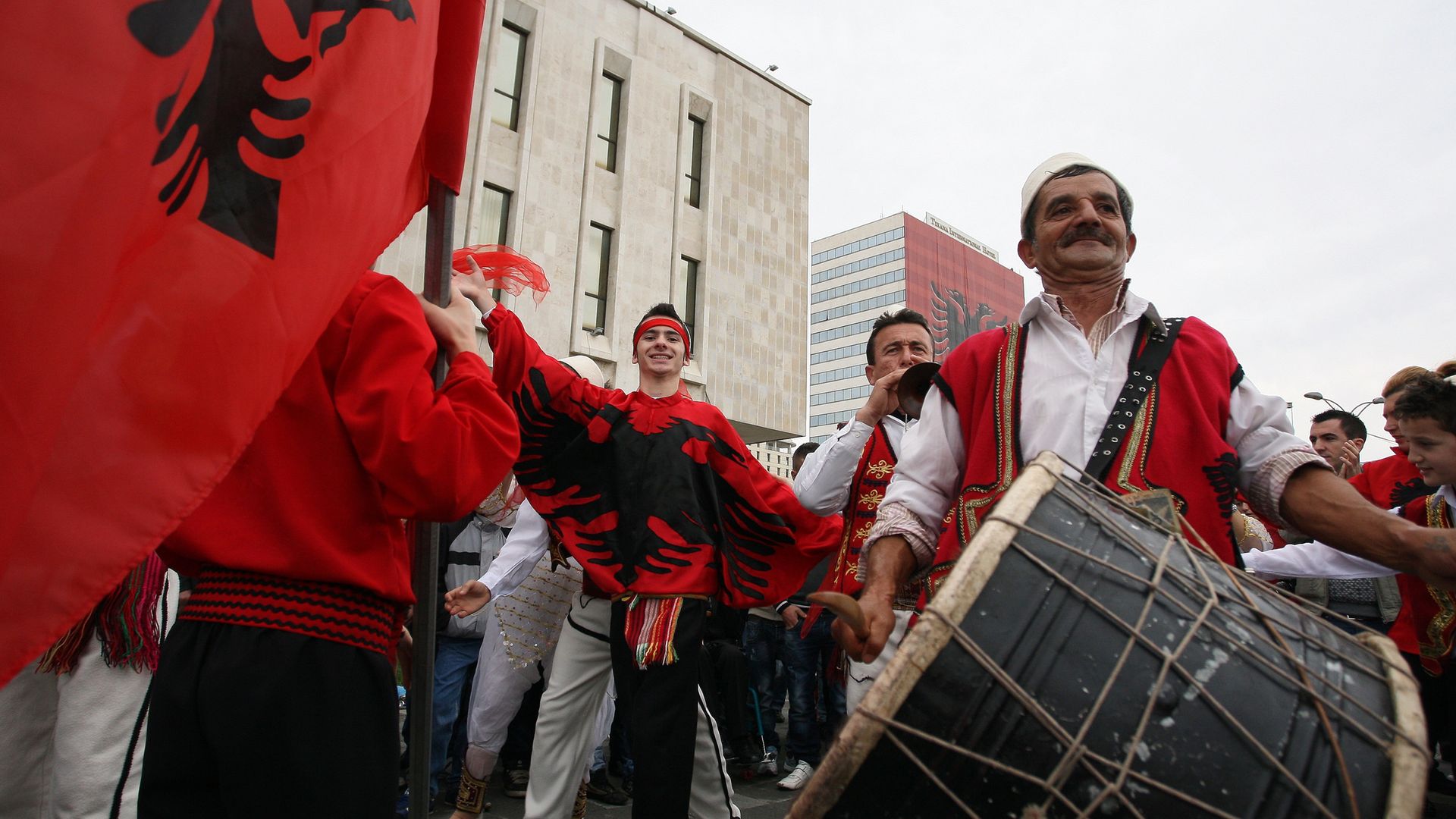
Not even the Albanian regime’s determination to seal itself off from the rest of the world could stop the sounds of the country’s capital.
Music thrives off cross-pollination. How, then, do musicians survive – let alone create – in an isolationist country where only a meagre diet of state-approved culture is on offer? Albania, and particularly the music of its capital, Tirana, provides some answers. During the four decades of communist rule under Enver Hoxha, this little Balkan country might as well have been on the moon for all the cultural variety officially permitted.
Hoxha’s Stalinism called for absolute cultural uniformity. And just as he tore the economic and social fabric apart, nationalising business and reorganising this undeveloped agrarian society via collective farms and industrialisation projects, a whole infrastructure of state cultural control arose to crush undesirable artistic expression and encourage ‘proper’ cultural values. After his 1961 denunciation of Khrushchev, Hoxha counted only China as an ally. When Mao died in 1976, Albania was truly on its own and was as culturally adrift as it was politically isolated. Hoxha’s program of building concrete bunkers across his country (bunkerizimi) was fittingly symbolic of a country trying to sequester itself from the world.
But suppressing the green shoots of musical creativity proved difficult. When the Tirana student protests began in late 1990, leading to the first democratic elections since the 1920s, held 30 years ago last month, University of the Arts students also marked the tenth anniversary of the death of John Lennon. They sang Revolution, Working Class Hero and Imagine and set about replacing the pictures of Hoxha and his successor, Alia, in their lecture halls with ones of Lennon.
The only Western personality sanctioned by Hoxha’s regime was Norman Wisdom, as the triumph of Wisdom’s downtrodden, working class Pitkin character over his social superiors was deemed ideologically sound. A former army bandsman, Wisdom’s songs like Don’t Laugh At Me (‘Cause I’m A Fool) (1954) revealed he was a more than adequate singer, and he was made an honorary citizen of Tirana in 1995. But in the student protests it was clear that by the 1990s Western influence had bypassed the regime’s barriers. Lennon’s music had circulated widely on illicit tapes but, even worse for the authorities, his many symbolic meanings had made it across the border too.
The decades before this were darker times, and it is difficult to overstate just how stifling the atmosphere was in Tirana for any type of music that could be described as ‘modern’. The one outlet for popular music was the annual Festivali i Këngës (Festival of Song), modelled on the San Remo Festival and characterised by the sort of light music sung by Tirana-educated singer Vaçe Zela, who won the inaugural contest in 1962 and went on to become a multiple winner and national institution. The Festivali i Këngës was, however, part of the planned music economy and dominated by the personnel of the state ensembles, which included Zela herself.
While the Festivali i Këngës was intended to produce songs ‘to be sung by the masses’, there was internal debate about what exactly this meant and in 1972 the songs performed drew the ire of the authorities for their ‘immorality’. The winning song, Kur Vjen Pranvera (‘When Spring Comes’), in which Tonin Tërshana crooned “Spring came/ But I did not believe it”, seemed to be open to a revolutionary interpretation. The Festival director was imprisoned and one of the presenters, the actor Bujar Kapexhiu, was sent to work in the Tirana brickworks. Albanian music entered a new period of draconian censorship.
But it was rock music that bore the real brunt of Hoxha’s prohibitions, and the flowering of Albanian-language rock took place in Kosovo rather than the country’s own capital. In a situation where beards and long hair were banned, even opportunities for sartorial signs of countercultural thought were vanishingly rare, but Tirana’s youth would not be discouraged and defied official proscriptions for decades before they were finally lifted in the 1990s.
The liqeni (‘lake’) bands were the nucleus from which Albanian rock later grew, so named for their illegal gatherings at the artificial lake in the south of Tirana. Here they would play the Beatles, Rolling Stones and Jimi Hendrix songs they had heard on crackly bootleg tapes and homemade radios tuned to Italian stations. In the absence of electrified rock instruments, folk guitars and anything that might be used as a drum were utilised, and among this loosely formed, DIY collective were Gjergj Jorgaqi, Aleksander Gjoka, Dashnor Diko and Elton Deda who would all go on to musical success in post-communist Albania.
By the time the liqeni were becoming a well-defined phenomenon, times were changing. Hoxha died in 1985 and his successor Ramiz Alia was faced with an undefeatable wave of popular discontent at the state of the country. In 1988 Aleksander Gjoka was permitted to organise Albania’s first official rock concert, staged inside Tirana’s Palace of Culture itself. The following year, at an assembly of the state-run Union of Albanian Youth, party officials were scandalised to hear the results of a recent anonymous poll: rock music was widely listened to and hugely popular.
Popular Italian husband and wife pop duo Al Bano and Romina Power were allowed to perform in the country in 1989, and by the summer of 1991 the authorities themselves were blasting out Western rock music in Skanderbeg Square. The previous February the square’s 40ft statue of Hoxha had been felled and elections had followed in March. Albania was on the path to a new future.
Since the arrival of democracy Albania has weathered many more storms, not least the 1997 collapse of the widespread pyramid schemes which almost led to complete societal meltdown; violence broke out, the government was toppled, and gangs and rebel groups seized local power. But Albanians have continued to push forward and look outward. Dance music – a culture without borders – has taken a hold in Tirana, with the Blloku district its hub. Once the exclusive domain of communist officials – Hoxha’s villa still stands at its centre – its concrete architecture which was once symbolic of the regime is now an asset in the constant race to be christened ‘the new Berlin’.
Slightly further north from Blloku, just off Skanderbeg Square, which is still dominated by the socialist realist mural of the National Historical Museum, is Minus 1, a venue in a former carpark which has drawn international dance acts to Tirana. Discobox, meanwhile, is another focus of the emergent Tirana dance scene, and is situated underneath the University of the Arts where the Lennon commemoration sparked a revolution.
DJ and producer Teelco studied at that same institution and is now one of the leading lights of Tirana techno and house. Anascole (Anastas Kolagji) from coastal Himarë is another Tirana scene regular, and the ION and Kala festivals, which take place on the Caribbean-white sands of Dhërmi Beach, a 30 minute drive up the coast from Himarë, are Albania’s premiere music events.
Albanian music now runs a full gamut, from the romantic ballads of Tirana-born Anjeza Shahini, who won the Festivali i Këngës, now turned a Eurovision entry competition, to represent Albania at their contest debut in 2004, to the gypsy punk of Fanfara Tirana, an ex-Albanian Army brass band whose jubilant fusion of disparate Albanian styles with dub reggae and jazz have made them favourites at European festivals. With the commencement of EU accession talks a year ago marking a new phase in its history, Albania continues its long journey from isolation to openness.
TRADITIONAL TUNES
Albanian folk music is incredibly diverse. The northern Ghegs and southern Tosks have different traditions, but the Ottoman-influenced urban lyric songs of the northern city of Shkodër, associated with singers Bik Ndoja, Xhevdet Hafizi and Luçije Miloti, thrived in post-war Tirana alongside the southern folk music of the musical dynasty La Famille Lela de Përmet. Latterly, Myslym Lela’s Romani-influenced music became one of the sounds most associated with Tirana. Under Hoxha, the southern Gjirokastër National Folklore Festival celebrated the polyphonic singing of the region and of Hoxha’s own Tosk culture.
What do you think? Have your say on this and more by emailing letters@theneweuropean.co.uk










